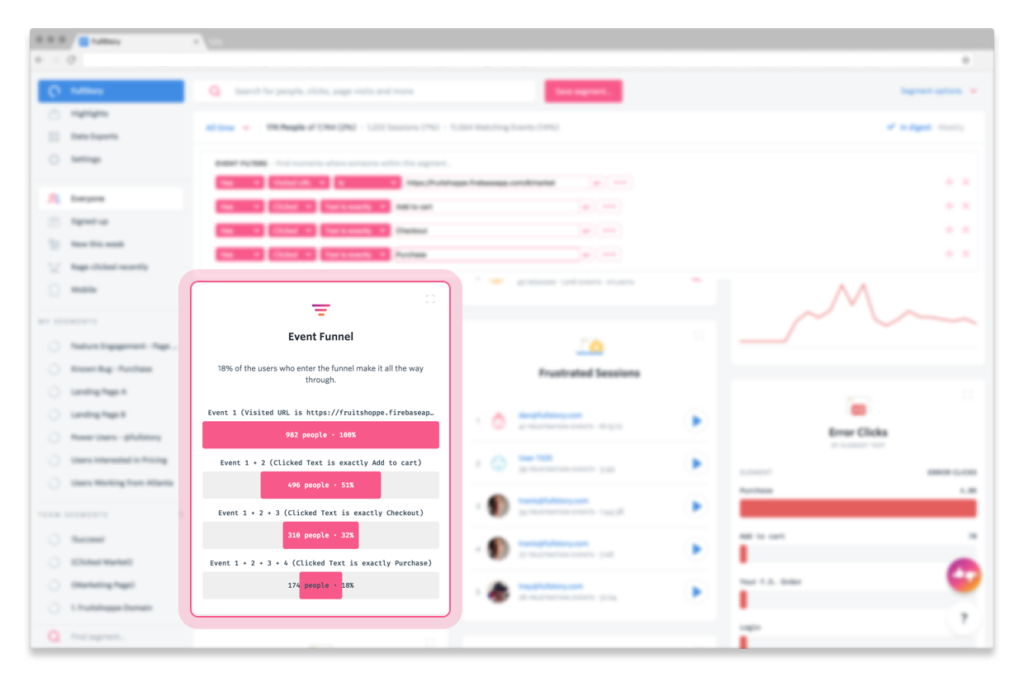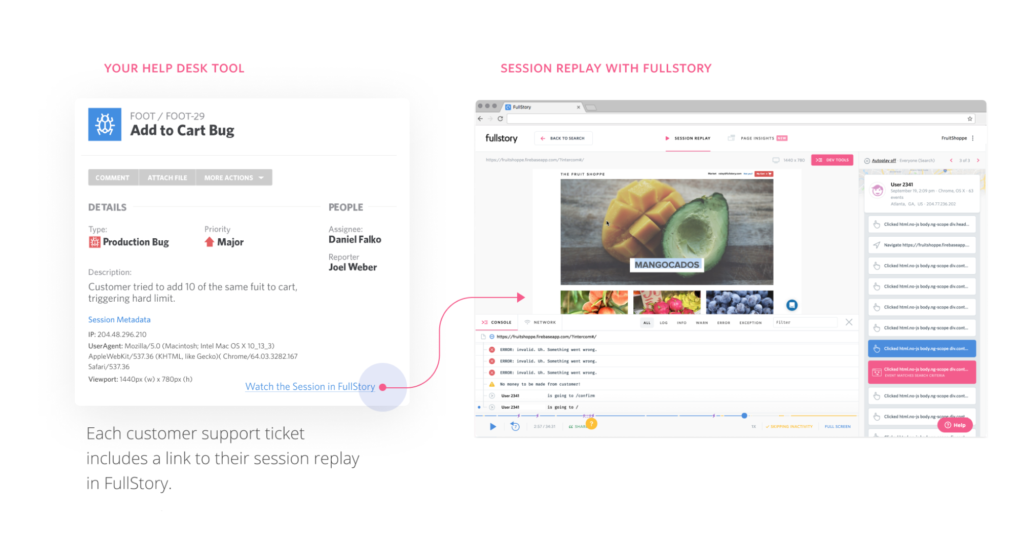
This post was written by Chris Samila, VP of Partnerships at FullStory. FullStory is our keynote sponsor of Click Summit 2019.
For millennia, the Golden Rule has illuminated the best way for people to treat and relate to one another: It’s with empathy. Trying to understand how another person thinks and feels in a specific situation is worth the effort every time. This is especially true when it comes to creating and optimizing digital experiences.
But because no one has the time or bandwidth to observe firsthand the experience of every single customer—this would quickly yield diminishing returns anyway—the key lies in practicing empathy efficiently, at scale. And that’s where today’s technology shines: It helps you focus on understanding what the experience of using your product or app is like for the users who struggle with it the most.
In this post, you’ll learn why a digital experience analytics platform is an invaluable tool for gaining quantitative and qualitative insights into how your customers want to be treated—and areas where your digital experience currently falls short. You’ll also learn the specific ways you can use these insights to generate hypotheses and run experiments to fix what’s broken and deliver gold-plated digital experiences for everyone.
Can Quantitative and Qualitative Data Work Together?
Traditional quantitative analytics—you know, bounce rates, conversion rates, and all the other KPIs you probably dream about in your sleep—do a great job of sounding the alarm when there’s something on a site or web app that’s failing to perform as it should. No problem there. But these analytics by themselves are unable to show you the reasons why there’s a situation. They can let you know there’s smoke, but they’re unable to show you what caused the fire.
A digital experience analytics platform, on the other hand, is able to help you sniff out trouble spots quantitatively and show you in pixel-perfect, qualitative detail what caused these experiences to go up in flames. This is because it automatically logs the entire experience of every visitor to your site or web app, without slowing down its performance. This log can then be searched and analyzed. What’s more, it can be used to create video-like replays of every user session.
You may be thinking this sounds like a staggering amount of data, and it is. But some digital experience platform technology is now so advanced that the process of searching and sorting data is practically as seamless as logging it. This makes it easy to investigate any conceivable issue with your customer experience and get as specific as you desire. Search for any cohort, any action, any sequence of actions, in any order, or in a specific order—all to quickly zoom in to the level of the individual user and get the context and nuance needed to explain aggregate numbers.
As a result, you can gain actionable insights that will help you decide definitively which issues to prioritize and how to fix them. And unlike regular usability testing, this type of research isn’t clouded by testing biases, and it’s not nearly as expensive.
You Got the Know-How. Now Add the Want-To.
To continue with the fire analogy from earlier, imagine you had chosen to be a fireman for a living rather than work on digital products and experiences all day long. (And considering how so much of your time is spent putting out fires, maybe this isn’t too much of a stretch.) Let’s say a building is engulfed in flames right in front of you, or even worse, someone is trapped inside. That’s all the motivation you need to get the blaze extinguished quickly.
While website and app work isn’t a matter of life or death, being so far removed from the frontlines of real customer experiences can dampen our empathetic response. Users become just another number, just another abstraction.
This is where the replay functionality of digital experience platforms shines. When you replay the sessions of individual users—when you watch them struggle with your own eyes and can practically see the soot on their faces—you can’t help but want to jump in and ask for a bucket.
What would it feel like if we were in this situation? Wouldn’t we want someone to make the page easier to use? To fix a bug? To make something less confusing? Session replay delivers clarity, context, and a rich understanding of how customers use your product. But just as importantly, it adds a sense of immediacy and purpose to our work and puts a human face on cold, stark numbers.
It allows you to relate to your users’ difficulties and take on their frustration as if it were your own. We believe it’s this ability to forge an empathetic connection with customers that helps build better products and ignite white-hot business growth.
So now you have insights into exactly what your customers go through—and a motivational fire lit under you to do something about it.
The only question: How do you do operationalize empathy at scale?
How Analytics and Empathy Can Best Work Hand in Hand
It’s simply not possible to replay the session of every person who visits your site—nor should you. So how do you pick and choose which sessions to watch? And what can you do once you watch them?
We’ve found a simple, repeatable process that is incredibly effective. It has 4 steps:
- Identify problems or specific digital experiences to optimize.
- Replay sessions, looking for patterns and trends until you have enough of a sense of what’s going on to generate a hypothesis.
- Test your hypothesis with your favorite experimentation tool.
- Analyze results both quantitatively and qualitatively, again leaning on the observations you make with replay.
You then repeat this four-step process—your empathy-to-action engine—until you get the results you need.
You’re probably thinking, “Easier said than done! How do you get started with Step 1?” Good question! Here are 5 ways you can use a digital experience platform to leverage the insights that will help you master this process and practice empathy efficiently and at scale.
1) Track the Temper Tantrums
Perhaps the best place to start is with the sessions of users who are having such a bad experience on your site that they take their frustrations out on their keypad or mouse. We’ve all been there: Perhaps a video is slow to load or a button or other element looks like it should link but doesn’t, and we unleash a torrent of rapid-fire button clicks or keystrokes in response.
Search for sessions containing “frustration signals” like Rage Clicks and Mouse Thrashes, and see exactly what’s testing your customers’ patience.

After watching frustrating sessions on a specific page or experience, you’re sure to have a handful of hypotheses to test and experiments to run. Before long, you’ll be ready to start smoothing out your customers’ desire paths.
2) Optimize Conversion Rates
Let’s state the obvious: There’s nothing cuddly about low conversion rates. They don’t give your bottom line much love, and they signify that your page content is giving users the cold shoulder. How do you replace bounces with embraces?

Search for sessions in which users have entered the conversion funnel but don’t make it all the way. Perhaps they’ve arrived at a landing page, or they’ve added something to their shopping cart. Then start observing their interactions and what might be preventing them from taking the final steps.
As with studying frustrating digital experiences in the section above, these insights can fuel highly strategic A/B tests. Run experiments and analyze the quantitative results. Then, dive into the replays of your A/B tests to see if you can learn even more.
3) Become a Traffic Cop
If you pull the trigger paid advertising campaigns, get ready for a silver bullet for boosting your return on ad spend.
You see, a digital experience platform can help you investigate the quality of the traffic from each one of your expensive referral sources more thoroughly than ever. Simply add a search filter to bring up the sessions of visitors who arrive from paid clicks off Facebook, Google, LinkedIn, or any other source you would like to analyze. You can add additional search parameters to narrow your focus as much as you’d like (for example, visitors who arrive via Facebook whose total active time is no more than 5 seconds).
Then observe how users behave—how fast they scroll, how long they stay on a page, where they click, or whether or not they complete the next KPI—to determine if the campaign is worth the investment. If you’re concerned about bots or other suspicious activity, this is the perfect method to gauge the validity of the traffic generated by each paid source.
Or perhaps you’ll notice that the quality of the traffic isn’t a problem, but the page layout is causing confusion. As you watch users struggle to find what they’re looking for, you’ll pick up ideas for optimizations you can make to improve conversion rates.
The bottom line is you don’t have to worry about squandering ad dollars on low-quality traffic or low engagement any longer. Your digital experience analytics platform will show you definitively if you need to shift spend to a different source, or if your focus needs to be on making changes to the page itself. Either way, you’ll be able to run campaigns with the confidence that your ad dollars are working as efficiently as possible.
4) Help Erase Errors
Few things send customers scurrying away from your site faster than a software bug. Fortunately, a digital experience platform is essentially like a magical can of bug spray for your engineers.
The process really is easy: Simply search for the sessions in which a user encountered an error—or call up a session from a support ticket. Prioritize your list of fixes. And then for each one, send your developers a link to watch the error unfold from the perspective of a user who experienced it.

This is one of those situations where empathy kicks things into high gear. When developers observe the pain that errors cause users, they’re more motivated to fix product problems fast.
In addition to seeing first-hand the sequence of events that triggered the error, developers also get a detailed replay of the user’s JavaScript console log. This means they no longer have to rely on guesswork or lose countless hours trying to replicate errors. They simply get everything they need to solve bugs, often within a matter of minutes. (And replay can help with testing and quality assurance (QA), too.)
5) Help Users Find What They’re Looking for
You never want your customers to start humming the U2 song “I Still Haven’t Found What I’m Looking For” while they’re searching for something on your site.
If your site has a search bar, search in your digital experience platform for sessions where search is used. Then, use replay to observe real users try to find the answers they need. Does your knowledge base contain the information your users are searching for? Are they able to find answers quickly or are they forced to enter multiple searches? Do some searches come up completely empty?
Use these insights to develop new help content and add keywords to your existing content to make it easier to find.
As you experiment with different approaches, you’ll monitor results both quantitatively and qualitatively. For inspiration, here’s one case where Shopify improved the experience on their knowledge base through observation and experimentation.
Rev Up Your Empathy Engine
Empathy is what empowers digital teams to understand clearly what’s not working—and find the motivation to fix it. The result is better products, apps, and experiences. The trick is in using empathy at scale—combining quantitative and qualitative approaches with informed experimentation to get results.
Use a digital experience analytics platform—one that includes search, analytics, and session replay—and run your simple, repeatable 4-step process. Before long, you’ll have the knowledge and the empathy needed to practice the Golden Rule of web optimization: to build sites and products that people can’t wait to tell others about.
And if you’re looking for a digital experience platform to drive your efforts, check out FullStory.










